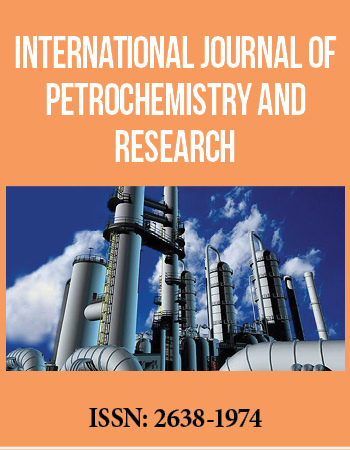Research Article
A Comprehensive Study of Thermal Stress on Limestone Rocks
1Abu Dhabi University, Chemical Engineering Department, P.O. Box 59911 Khalifa City, Abu Dhabi United Arab Emirates
2Dalhousie University, Canada; Emertec R&D Ltd, Halifax, Canada
3United Arab Emirates University, Chemical & Petroleum Engineering Department, P.O. Box 17172 Al-Ain City, United Arab Emirates
*Corresponding author: Omar Chaalal, Abu Dhabi University, Chemical Engineering Department, P.O. Box 59911 Khalifa City, Abu Dhabi, United Arab Emirates, Tel: +971555423254, E-mail: omar.chaalal@adu.ac.ae
Received: March 8, 2017 Accepted: April 5, 2017 Published: April 11, 2017
Citation: Chaalal O, Islam MR, Zekri AY. A Comprehensive Study of Thermal Stress on Limestone Rocks. Int J Petrochem Res. 2017; 1(1): 19-25. doi: 10.18689/ijpr-1000105
Copyright: © 2017 The Author(s). This work is licensed under a Creative Commons Attribution 4.0 International License, which permits unrestricted use, distribution, and reproduction in any medium, provided the original work is properly cited.
Abstract
Petroleum resources continue to dominate the energy sectors with no sign of a
decline. Petroleum reserves, however, are dwindling in view of fewer new discoveries
and increased production level. It is important to determine petroleum reserves
accurately in order to correctly forecast energy budget in the future.
The most commonly used methods to describe the fluid flow in oil reservoirs employ
constant rock properties. However, these methods are not applicable to reservoirs that
undergo changes in the rock properties due to variation in pore pressure. Common
characteristics of fractured reservoirs are sensitivity of permeability and porosity to
effective stress. The in-situ stress, in itself, can be of mechanical or thermal origin. The
thermal stress can be significant in thermal enhanced oil recovery schemes such as
injection of cold fluid in hot formation during water flooding or wastewater disposal, or
even during hydraulic fracturing.
Unfortunately, the most commonly literature review reveals that the research in this
area has been focused mainly on thermal recovery of heavy oil. Few investigation, however, have been done on the onset and propagation of fractures under thermal
stress or mechanical stress. Consequently, this paper is devoted to investigate fracture
development and propagation in carbonate formation under thermal and mechanical
stress. A series of experiments were ingeniously designed to study the effect of thermal
stress on fractured carbonate formation. Laboratory experiments were conducted to
determine stress-strain relationship and the time dependence taking in account fracture
formations and their propagation. A computer image analyzer was used to observe the
fracture/fissures distribution for various cases of thermal stress on carbonate rocks. The
role of thermal and mechanical stress in determining orientation and propagation of
fractures was also studied.
Keywords: Thermal stress Petroleum reserve, Strain, Carbonate rocks, fracture.
Introduction
Transient thermal stresses are of great importance in many applications that deal
with large temperature changes. Applications range from the field of microelectronic
processes to geothermal processes. In general thermal problems encountered in the
field of earth science involve a combination of a solid state and fluid state, whereas in
other fields thermal processes deal with microscopically homogenous structures (e.g. manufacturing of mechanical devices).
The study of thermal stress in a homogeneous, isotropic
medium started decades ago [1-2] and most of the problems
encountered in this area are either amenable to analytical
solutions [3] or solved by means of perturbation approach [4]. However, if a body has anisotropic properties, it is more
complicated to predict the temperature field and the stresses; numerical method appears to be the method of suitable
choice [5].
Wu [6] proposed three different methods to calculate
thermal stress. The first is an analytical method that involves an
exact solution similar to those encountered in elastic theory. The
second method uses the technique of approximations such as
the perturbation procedure. Finally, the third method uses
numerical techniques to solve the governing partial differential
equations.
Even though various forms of semi-analytical methods
have been proposed to alleviate the difficulty of large number
of grid blocks, numerical methods continue to be common in
determining the stress field of a body subjected to thermal
stresses. In these cases, the emphasis has been focused on the
thermal stress coupled with mechanical stress that originates
from pore pressure as well as overburden stress. Gai [7] (2004) summarized some of the salient aspects of Geomechanics
modeling and highlighted the need of modeling thermal stress.
Ghassemi [8] showed that rock mechanics research and
improved technologies can impact areas related to in-situ
stress characterization, initiation and propagation of artificial
and natural fractures, and the effects of coupled hydro-thermochemo-
mechanical processes on fracture permeability and
induced seismicity. Recently, Ghassemi and Tarasovs [9]
investigated the development and propagation of system of
crack from a cooled wellbore, and secondary thermal cracks in
geothermal reservoir due to cold water injection is studied. The
extent of the thermal fractures and their spacing is estimated
using a combination of the real boundary integral equation
method for the temperature solution, and the complex variable
boundary integral equation for fracture propagation solution. The results showed that the influence of thermal stress on
fractures and their propagation is considered for the problem
of sudden cooling of a rock half-space, injection/extraction
process in fractures, and cooling of a wellbore.
In a review article, Obembe [10] showed that the subject
of heat transfer in oil reservoirs has gained huge attention, due to its diverse range of applications in petroleum reservoir
management and thermal recovery for enhanced oil recovery.
Thermal Stress in a Petroleum Reservoir
Most light oil reservoirs in the UAE experienced significant
decline in reservoir pressure; therefore there is a great need for
initiating pressure-maintenance and/or enhanced oil recovery
schemes. UAE reservoirs are mainly carbonate, limestone and
dolomite formations that are subject to natural fractures and
fissures [11]. However, even when natural fractures are nonexistent
within the reservoirs, the use of fluid injection at
ambient temperature causes thermal stresses. This can be
explained by the fact that the UAE reservoirs are at high
temperature (in the neighborhood of 90 C). Furthermore, this phenomenon is applicable to heavy oil reservoirs, which are
shallow and constituted of unconsolidated sands when they
are subjected to steam or other form heat induction [12]. Consequently, most research activities have focused on
determining thermal stress in unconsolidated formations [13]
and mechanical strength for unconsolidated formations [14]. Little work has been done in determining thermal stress for
deep carbonate formations.
In a thermal recovery techniques study, the thermal stress
process is generally not known a priori or only with insufficient
accuracy. In the late 80ʼs, however, attempts have been reported
in the formulation of the thermal process, Tortike and Farouq
Ali [15] presented a formulation in which both thermal and
mechanical stresses are considered. Thus, the Tortike and
Farouq Ali study can be seen as the first attempt to model
subsidence under thermal recovery technique. Unfortunately, the study did not present any solutions to the problems; hence
no critical judgment can be made on the formulation.
Interestingly, Chalaturnyk and Scott [16] did not report
any effect of thermal stress. For their case of unconsolidated
sand, thermal stress may well be negligible as compared to
mechanical stress. This is an aspect that has yet to be studied.
In a similar study Chen et al. [17] presented a comprehensive
formulation for simultaneously modeling fluid flow and
Geomechanics. The study did not include thermal stress and
the results were not provided.
Note that temperature changes in the rock induce thermoelastic
stresses Hojka et al. [18]. These stresses cause thermal
strains that can eventually lead to rupture or shear. The
temperature dependency of the thermal stresses can cause
enormous variations in the magnitude of the thermo-elastic
stresses over a reasonable temperature ranges. Thermal stress
is complex and cannot be handled easily, and in general, a
multidimensional search problem must be solved, which can be
difficult in practice. However, theoretical .estimates of the
stresses can be calculated from equations of fluid-saturated, pore-elastic solids by incorporating thermo-elastic rock volume
changes. The calculation is straightforward if the effects due to
nonlinear deformation module and the elastoplastic processes
are neglected.
It is clear from the preceding that the calculation based
on both nonlinear deformation and elastoplatic processes
may be a demanding problem from the computational point
of view. Biot [19] proposed equations for pore-elastic theory, and Schiffman [20] studied the stresses and included the
thermal effects into Biotʼs theory. Notice again that the
inclusion of the thermal conduction to the original theory was
considered to be a difficult task and was only accomplished in
the mid 80ʼs [21].
Furthermore, Kurashige [22] reported the first coupling of
conduction and convection in the context of thermal stress. Kurashige provided numerical solution for the governing
equations. Hojka et al. pointed out that Kurashige work
presented inappropriate formulation. They postulated that
Kurashige allowed the thermo-elastic stresses to reach the hot
fluid front and such action makes the model unrealistic.
Further evidence of the weakness of such model arises from
the fact that Kurashige imposed steady-state pressure
distribution, leading to poroelastic responses that are not
time dependent.
An elaborated technique was performed by Vafai and
Sozen [23] to solve the problem. The technique consist of
solving the energy balance twice using the approach originally
outlined by Chan and Banerjee [24] to solve the energy
balance equation with a two-equation model.
This essentially involves solving the energy balance equation
with thermal properties of the rock and fluid separately. A heat
transfer coefficient was incorporated in order to account for the
transfer of energy between the fictitiously separated rock and
fluid body. The study demonstrated that there is a lag between
fluid and solid temperatures because heat propagation in the
fluid is due to convection and conduction whereas the propagation
of heat in the solid phase is governed only by conduction.
Hojka et al. derived the transient temperature and stress
fields in a two-dimensional domain during constant rate, constant temperature fluid injection. The energy equation was
considered to be different for the fluid and the rock. However, the complete conduction equation was not solved for the
solid. The procedure consisted of calculating the pore pressure
first then the results permitted to evaluate the solid temperature
and volume change potentials. Subsequently, rock responses
due to thermo-elastic and poroelastic changes were calculated. They re-affirmed the previous observation that the pressure
front propagates faster than the thermal front. One of their
major findings was that small changes of pressure do not
induce large poroelastic stresses; leading them to believe that
these effects can be neglected. They observed that the thermoelastic
stress changes are limited to the heated or cooled zone
in the region between the borehole wall and the injected fluid
front. Finally, they demonstrated that shear failure or hydraulic
fractures can be initiated on the wall depending mainly on the
temperature of the injected fluid.
Dusseault [25] outlined stress changes during a thermal
operation. He identified the following effects that make the
thermal loading a non-linear problem:
-- Rotation and alteration of principal stress fields;
-- Changes in volume and stress (in magnitude as well
as direction);
-- Yield and dilation of the reservoir, leading to changes
in absolute and relative permeabilityʼs;
-- Change in overburden and under burden properties
due to tensile or compressive cracking or shear yield;
-- Reservoir shearing or overburden cracking due to
high pore pressure, thermal stresses, and weakening
from yield.
The existence of so many governing parameters and their
interactions make the problem intractable. Dusseault suggested
that conceptual models be used to aid understanding of the
problem before coupling with a reservoir model. He reported
a series of configurations for the Geomechanics model, but
did not make any effort to couple the model with a fluid flow
simulator.
Hojka et al. reported the coupling of convection and
conduction for the plane strain borehole. They limited their
investigation to single-phase flow. Also, the focus of this
investigation was the fluid flow and energy balance equation. No effort was made to couple fluid with Geomechanics
modeling.
Stress changes due to temperature: a simple Model
Dusseault presented the following simple model of stress
changes as function of temperature changes assuming the
following:
-- a permeable reservoir at initial stress conditions σv1σhi, σh2, pore pressure u.
-- temperature to principal stresses corresponds to
vertical and horizontal directions.
-- linear elastic behavior and Hookʼs Law applies:

Ei, v and β are Youngʼs modulus, Poissonʼs ratio, and the coefficient of linear thermoplastic expansion. The stress strain law is written in terms of effective stress changes Terzaghiʼs effective stress law is assumed to apply for incremental principal stress changes (∆σi):

where α is Biotʼs parameter; α = 1.0 in this analysis. The reservoir is laterally extensive, thus the total vertical stress is approximately unchanged during uniform pressure or temperature changes; ∆σv = 0. Assuming a uniform pressure change ∆T = 0), one may show:

Note that stress changes because of injection or
production can lead to shearing or tensile yield, depending
on initial conditions, Poissonʼs ratio, and the process.
In the more general case, ∆u and ∆T ≠ 0, where u is the
internal energy. Using the same boundary conditions and the
equations above, one may show:

h is a dummy variable.
Note that a temperature change causes a stress change
proportional to the stiffness (E), whereas a pore pressure
change does not.
This model was adopted by S. Goodarzi et al [26], who
simulated CO2 sequestration and storage.
Objectives
This research is aimed at developing a comprehensive
technique for characterizing onset and propagation of fractures
in a porous medium under thermal stress. A series of laboratory
experiments were conducted, followed by computer image
analysis in order to observe the fracture/fissures distribution for
various cases of thermal stress on carbonate rocks.
Material and Apparatus
Carbonate Samples
Limestone cores, obtained from outcrops at Hafeet
Mountains (Al-Ain, UAE), were used to prepare core samples
for porosity and permeability measurements. Two types of
cores were used in this study, fractured and no fractured
cores. For scanning electron microscope analysis, small sample
of each core used in the study were obtained prior to and
after thermal shock. The carbonate rocks samples were cut
into six small disks 25.4 mm in diameter and 5 mm in thickness.
Scanning Electron Microscope (SEM)
SEM was used in this study to characterize pore size and
pore structure of the carbonate samples prior to and after
thermal shock. The SEM generates an electron beam from the
electron gun. This beam is focused and illuminated on the
specimen. As the beam is scanned over the specimen surface
in both X and Y directions, secondary electrons back scattered
are detected. Amplifying these electron signals and modulating
their brightness on the observation cathode ray tube display a
specimen image displayed on the cathode ray tube.
Computerized Image Analyzer
A computerized image analysis system was used to study
rock samples structure prior to and after thermal shocks. The
basic system consists of a high-resolution video camera on an
optical microscope, an imager processor, a Pentium PC, a
high-resolution image monitor, and a high-resolution text
monitor. The image is visualized with the video camera through
a microscope lens. As soon as binary images are produced
from an accepted microphotograph, a feature count can be
performed. Simply selecting the desired bit plane and
activating the count option accomplish this objective.
Stress and stain devices
The compressive stress was performed using Conslo type
machine WF55205/6, Wykeham Farance Eng. Meanwhile the
stress-strain test was performed using Material Testing System (MTS) H20.
Experimental Procedure
Porosity and permeability measurements
Core porosity was measured using the weighing method
technique meanwhile liquid permeability method was used to
determine core permeability.
Submerging
This method was easy to apply, it consisted of the
following:
• Heating the sample until it reaches the requested
temperature to make sure that the whole sample (inside and outside) is at the desired temperature we
left it in the oven for about 24 hours.
• Preparing a 30°C water in an appropriate quantity
and through the sample in it, then wait for 10 - 20
minutes.
• Finally, dry the sample, and then do the liquid
permeability measurements using the liquid
Permeability Apparatus.
Stress and strain measurements
The experimental study of the effect of thermal shock on
stress and strain of lime stone was conducted using nonfractured
cores. The study was mainly focused on the
compressive stress test and tensile tests. Rocks prior to and
after thermal shocks were tested. Microphotos of rock samples
were obtained prior to and after thermal shocks using SEM
and Image Analyzer System, to investigate and try to observe
the creation of any micro-fractures as a result of thermal
shock.
Results and Discussion
Effect of thermal shock on cores
Two sets of cores were used to test the effect of thermal
shock on rock permeability. The first set consists of four nonfractured
cores 1MIS, 2MIS, 3MIS, and 4MIS having the
following initial permeably: 0.11, 7.17, 20 and 23.14
respectively. To simulate the temperature shock, the cores
were heated at 100 and 150°C for 24 hours to reach the
desired temperature. When the heating process reached the
set temperature, the cores were taken from the oven and
immediately immersed into water at 25°C. Permeability
measurements of the cores were performed on the thermally
shocked cores. Fig. 1 shows the effect of thermal shock on
non-fractured core permeabilityʼs. From Fig. 1 one can see
that the thermal shock showed a negative effect on nonfractured
core permeabilityʼs. Around 50% reduction on
permeability of core 1MIS was observed as a result of thermal
shock at 150°C. Thermal shock produce a shrinkage of rock
which seems to result in damaging the channels that
connecting the pores and responsible of core permeability. At
very low permeability (0.11 Md.) this phenomena did not take
place as shown in Fig.1. Therefore non-fractured core
damaging due to thermal shock is function of permeability
and thermal shock has no effect on very tight formation.
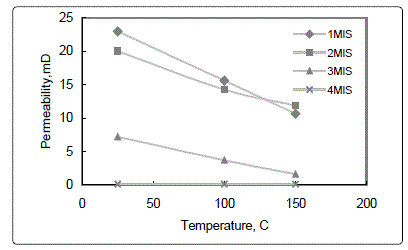
Figure 1: Effect of thermal shock on non-fractured core permeability
The second set consists of fractured core samples. Thermal shock procedures were repeated on the fractured core samples at temperatures of 150 and 200°C. Thermal shock observed to produce a positive effect on the fractured core permeability as shown in Fig. 2. The percent improvement of fractured core permeability is function of temperature. Increasing the thermal shock temperature tends to result in increasing % improvement of the thermally shocked fractured core permeability. Thermal shock tends to extend the existence fractures producing improvement in over all permeability of the fractured rock. This phenomenon was confirmed by taken micro photos of the tested rocks before and after thermal shocks. Figs. 3 and 4 show fractured rocks before and after thermal shocks of 150°C and Figs. 5 and 6 represent the thermal shock of 200°C. Fracture areas for both systems prior to and after shocks were measured using Computerized Image Analyzer. A significant increase in the fractured area after thermal was obtained, which confirms previous findings. Fig. 7 qualitatively shows σθ and σr around contraction inclusion Dusseault, in a region that is being cooled by cold-water injection in stressed porous media. Dusseault indicated that because of negative ∆V, material within the cold zone behaves “less stiff” than the surrounding media; stresses are shed to the surrounding materials. Dusseault introduced the concept of thermal contracting inclusion in a region that is being cooled by cold-water injection in a stressed porous media. He indicated that continued heat extraction due to the sudden cooling process enhances the rock fractures as shown in Fig. 7, which confirm the phenomena reported previously. All of the work conducted by Dusseault is a theoretical work.
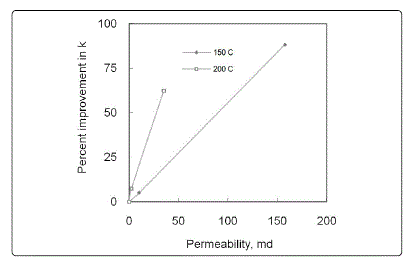
Figure 2: Effect of thermal shock on fractured cores permeability
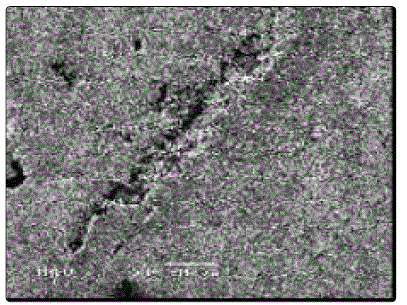
Figure 3: Micro-photo of fractured core before thermal shock
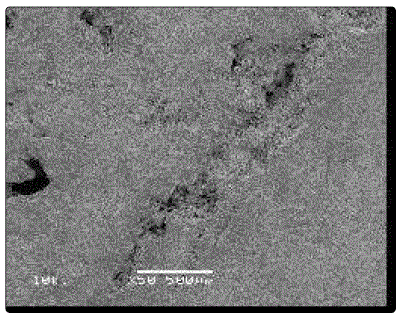
Figure 4: Micro-photo of core sample after thermal shock, T= 150 °C.
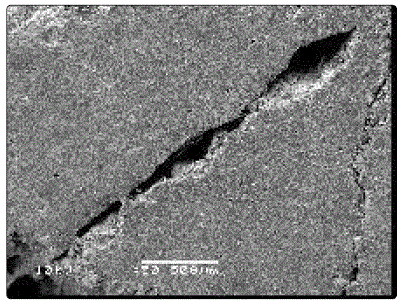
Figure 5: Micro-photo of fractured core before thermal shock for the sample exposed to 200 C

Figure 6: Micro-photo of fractured core after thermal shock, T °C = 200
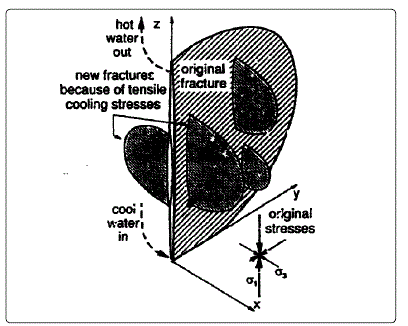
Figure 7: Geothermal fractures, large scale cooling, after Dusseault (Ref. 25).
Stress and strain of thermally shocked rocks
Non-fractured limestone rocks were used to investigate
the effect of heat and thermal shocks on stress and strain of
these rocks. Carbonate rocks obtained from the same outcrop
having different porosity and permeability was used in this
phase of the project. Initially, compression tests were
performed on the selected cores prior to heating, after heating
and after thermal shocks. Rocks were heated to the same
temperature of 150°C. Fig. 8 shows fracture pressure versus
permeability for non-heated, heated and thermally shocked
systems. Thermal shock results in significant reduction of
fracturing pressure for all studied systems. Expansion and
contraction of the carbonate rocks as a result of heating then
cooling tends to weaken the rock, which resulted in lowering
its fracture pressure. The following equations were obtained
from the plotted data of Fig. 8:
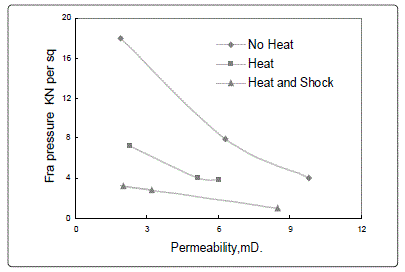
Figure 8: Permeability vs. fracture pressure for different systems
In the above, R2 values indicate near perfect correlation. The previous equations could be used to roughly estimate fracture pressure of thermally shocked limes stone strata providing availability of its permeability data. Dusseault concluded (based on theoretical work) that stress is decreases due to cold-water injection as observed experimentally in this project, as indicated in Fig. 9.
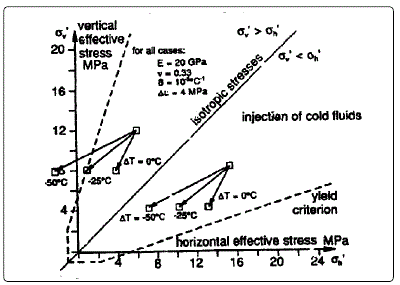
Figure 9: Stress paths for a temperature decrease, after Dusseault (Ref. 25).
Secondly, tensile tests (stress vs. strain) were performed on similar cores under different thermal (shock) stress conditions: 200, 250, and 300°C. The results of these tests is compared with a base case, no thermal shock, is shown in Fig. 10. Again the thermal shock reduced the fracture pressure of all tested samples as we compare them to the base case. Wang et al. investigated the behavior of poorly-consolidated sandstone under different loading procedures. They concluded that, for the same in situ stress, well bore hydraulic fracturing pressure might respond totally different when different stress paths have been followed. The stress history, strain path, and pore pressure distribution are critical to correctly simulate fracture propagation in poorly-consolidated sandstone.
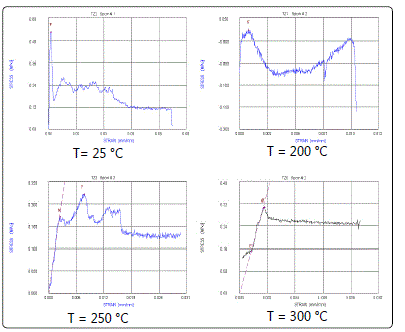
Figure 10: Stress-Strain relationship before and after thermal shocks for different temperatures
Conclusion
The following conclusions can be drawn from this study: 1. The thermal shock affects non-fractured core
permeability negatively.
2. Non-fractured core damaging due to thermal shock
is a function of permeability, further the thermal
shock has shown no effect on very tight formations (k= 0.11).
3. Thermal shock produces a positive effect on the
fractured core permeability.
4. The increase of the thermal shock temperature tends
to increase the percent improvement of the thermally
shocked fractured core permeability.
References
- Timoshenko S, Woinowsky-Krieger S. Theory of Plates and Shells. 2nd Edition, McGraw-Hill, New York. 1959.
- Boley BA, Weiner JH. Theory of Thermal Stresses. John Wiley & Sons, New York. 1960.
- Das YC, Navaratna DR. Thermal bending of rectangular plates. J. Aerospace Sci. 1962; 29: 1397-1399.
- Stavsky Y. Thermoelasticity of heterogeneous aeolotropic plates. ASCE J. Eng. Mech. Div. 1963; 89: 89-105.
- Chen PYP. Transient thermal stresses in a rectangular plate due to nonuniform heat transfer coefficients. J. Thermal Stresses. 1988; 11: 115-125. doi: 10.1080/01495738808961924
- Wu S. Analysis on transient thermal stresses in an annular fin. J. Thermal Stresses. 1997; 20: 591-615. doi: 10.1080/01495739708956120
- Gai. X. A Coupled Geomechanics and Reservoir Flow Model on Parallel Computers. Ph.D. thesis, University of Texas at Austin, Texas, 2004.
- Ghassemi A, Tarasovs S. Analysis of Fracture Propagation under Thermal Stress in Geothermal Reservoirs. Proceedings World Geothermal Congress 2015 Melbourne, Australia, 19-25 April 2015.
- Obembe AD, Abu-Khamsin SA, Hossain ME. A Review of Modeling Thermal Displacement Processes in Porous Media. Arab J Sci Eng. 2016; 41(12): 4719–4741. doi: 10.1007/s13369-016-2265-5
- González-Gómez WS, Alvarado-Gil JJ. Thermal effects on the physical properties of limestones from the Yucatan Peninsula. International Journal of Rock Mechanics and Mining Sciences. 2015; 75: 182-89. doi: 10.1016/j.ijrmms.2014.12.010
- Dusseault MB, Simmons JV. Injection induced stress and fracture orientation changes. Canadian Geotech. J. 1982; 19 (4): 483-93.
- Islam MR, Chakma A, Farouq Ali SM. State-of-the-art of in situ combustion modeling and operations. paper SPE-18755, Proc. Of the SPE California Regional Meeting, Bakersfield, CA, (April 1989.
- Islam MR, George AE. Sand control in horizontal wells in heavy oil Reservoirs. J. Pet. Tech. 1991; 43 (7): 844-853. doi: 10.2118/18789-PA
- Tortike WA, Farouq Ali SM. A framework for multiphase nonisothermal fluid flow in a deforming heavy oil reservoir. paper SPE 16030 presented at the Ninth SPE Symposium on Reservoir Simulation, held in San 1991. Antonio, TX, Feb. 1987.
- Chalaturnyk R, Scot J.D. Geomechanics Issues of Steam Assisted Gravity Drainage. paper SPE 30280 presented at the International Heavy Oil Symposium held in Calgary, Alberta, Canada, 19-21 June 1995.
- Chen HY, Teufel LW, Lee RL. Couple fluid flow and Geomechanics in reservoir study-I. Theory and governing equations.” Paper SPE 30752, paper presented at the SPE Annual Technical Conference and Exhibition, held in Dallas, USA, 1995.
- Hojka K, Dusseault MB, Bogobowicz A. Analytical Solutions for Transient Thermoelastic Stress Fields around a Borehole during Fluid Injection into Permeable Media. Journal of Canadian Petroleum Technology. 1993; 32(4): 49-57. doi: 10.2118/93-04-03
- Biot MA. General solutions of the equations of elasticity and consolidation for a porous material. App Phy J. 1956; 78: 91.
- Schiffman R.L. A tehrmoelastic theory of consolidation. Environmental Geophysics and Heat Transfer. 1971; 4: 78.
- Booker JR, Savvidou C. Consolidation around a spherical heat source. Int. J. Solids Structures. 1984; 20: 1079.
- Kurashige MA. Thermoplastic theory of fluid-filled porous materials. Int. J. Solids Structures. 1989; 25(9): 1039-52. doi: 10.1016/0020- 7683(89)90020-6
- Vafai K, Sozan M. Analysis of energy and momentum transport for fluid flow through a porous bed. J. Heat Transfer. 1990; 112(3): 690-99. doi: 10.1115/1.2910442
- Chan YT, Banerjee S. Analysis of transient three-dimensional natural convection in porous media. J. Heat Transfer. 1981; 103(2): 242-48. doi: 10.1115/1.3244448
- Dusseault MB. Stress changes in thermal operations.” Paper SPE 25809, paper presented at the SPE Int. Thermal Operations Symposium, Bakersfield, CA, and Feb. 1993.
- Goodarzi S, Settari A, Zoback M, Keith DW. Thermal Aspects of Geomechanics and Induced Fracturing in CO2 Injection With Application to CO2 Sequestration in Ohio River Valley”. SPE International Conference on CO2 Capture, Storage, and Utilization, New Orleans, Louisiana, USA. 2010.

